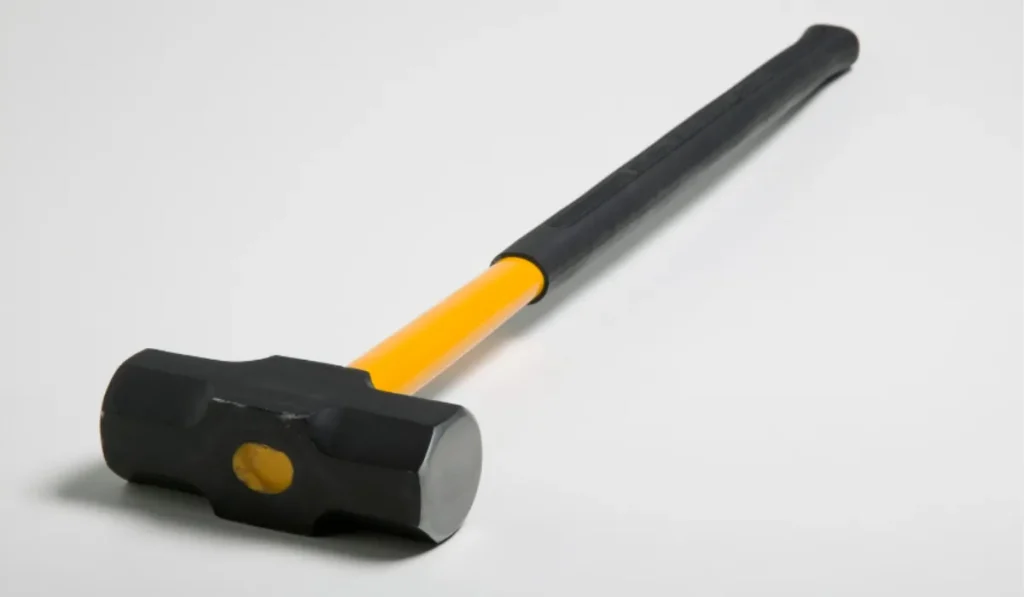A typical sledgehammer weighs between 2 to 20 pounds (0.9 to 9 kg). This range varies based on the sledgehammer’s size and intended use.
Sledgehammers are heavy-duty tools designed for delivering powerful blows, often used in construction and demolition tasks.
They consist of a large, flat, metal head attached to a long, sturdy handle. The weight of a sledgehammer is an important factor that contributes to its effectiveness at breaking through tough materials such as concrete, stone, or metal.
While a heavier sledgehammer can provide more force, it also requires greater strength and stamina to use.
Conversely, lighter models might offer better control and be suitable for less intense tasks.
Selecting the right sledgehammer for the job hinges on a balance between its weight and the specific needs of the user and the project.

The Sledgehammer Defined
A sledgehammer is a tool with a large, flat, metal head attached to a long handle. The head of the sledgehammer is its main weight source. People use this powerful hand tool for a variety of heavy-duty tasks.
They need strength and precision to handle it. Sledgehammers can weigh from as light as two pounds to as heavy as twenty pounds or more.
Components And Build
The sledgehammer comprises two main parts: the head and the handle. Its distinctive build allows for forceful swings.
- Head: Made from high-grade steel, and its weight affects the hammer’s purpose.
- Handle: Usually wood or fiberglass, the handle offers grip and leverage.
Varying Types And Uses
Several sledgehammer types exist, each serving a different use. Their uses are diverse and extensive.
| Type | Weight | Common Use |
|---|---|---|
| Light Sledgehammer | 2-4 lbs | Tile and drywall removal |
| Medium Sledgehammer | 6-8 lbs | Concrete and driving stakes |
| Heavy Sledgehammer | 10+ lbs | Breaking stone or metal forging |
Each type is designed for specific impact and control.
Weights And Measures

Understanding the Weights and Measures of sledgehammers is key for choosing the right tool. They range in weight to suit different tasks, from demolition to driving stakes.
Standard Weight Range
Sledgehammers vary in weight to meet diverse needs. The standard weight range is critical for appropriate selection.
| Weight (lbs) | Common Uses |
|---|---|
| 4 – 6 | Light demolition, driving small stakes |
| 8 – 12 | General demolition, driving large stakes |
| 14 – 20 | Heavy demolition, concrete breaking |
Factors Influencing Weight
Several factors play a role in determining the weight of a sledgehammer. Let’s explore these closely.
- Material: Steel and fiberglass handles influence weight.
- Length: Longer handles can lead to heavier hammers.
- Head Design: Various shapes affect overall weight.
Sledgehammers In Action
Visualize a tough demolition scene or construction workers clearing a site. This is where you witness sledgehammers in action.
Ranging from home renovations to industrial landscapes, these hefty tools are the heroes of deconstruction.
Functional Uses In Different Industries
Sledgehammers serve numerous purposes across various fields. Their sheer weight and strength aid in several tasks.
- Construction – Toppling walls, breaking concrete
- Agriculture – Driving fence posts into the ground
- Blacksmithing – Forging metal, shaping iron
- Firefighting – Forcible entry during emergencies
- Railways – Maintaining tracks, driving spikes
Impact Force And Physics
The science behind a sledgehammer’s strike explains its effectiveness. It can be boiled down to mass and acceleration.
| Element | Description |
|---|---|
| Mass (Weight) | A heavier head delivers a more powerful blow. |
| Acceleration (Speed) | Speed of swing increases impact force. |
| Force Equation | Force = Mass x Acceleration |
During use, the swing momentum coupled with gravity’s pull ensures a forceful impact.
Choosing The Right Sledgehammer

Embarking on a project that calls for a sledgehammer? Picking the perfect one is crucial. Each task demands a specific weight and design to ensure efficiency and safety.
Let’s dive into choosing the right sledgehammer for the job at hand.
Weight Considerations For Various Tasks
Sledgehammers vary in weight, typically ranging from 2 pounds to 20 pounds. The key is to match the tool’s weight to the intended task.
- Light-Duty Tasks: A sledgehammer between 2 to 4 pounds is ideal. It suits tasks like driving tent stakes or small demolition projects.
- Medium-Duty Tasks: Weights of 6 to 8 pounds are best for tasks like breaking up concrete or driving in fence posts.
- Heavy-Duty Tasks: Go for a sledgehammer between 10 to 20 pounds for heavy demolition or driving large wedges.
Choose a weight that you can handle comfortably for extended periods to avoid fatigue and injury.
Material And Handle Length
The material of the head and handle, along with handle length, also affects your sledgehammer choice.
| Material | Handle Length | Task Suitability |
|---|---|---|
| Forged steel head | Short (15 – 30 inches) | Precision work, limited space |
| Cast iron head | Medium (30 – 36 inches) | General tasks, more leverage |
| High-impact materials | Long (36 inches and above) | Maximum force, large-scale demolition |
Forged steel heads are durable and can tolerate repetitive striking. Cast iron is a bit more brittle but still effective for certain tasks.
High-impact materials like carbon fiber or fiberglass offer durability without excessive weight.
Handle length influences control and power. Short handles allow for more accuracy in tight spaces.
Long handles provide greater swinging force for larger jobs. Always opt for a handle that complements the task and ensures a secure, comfortable grip.
Safety Precautions
Safety precautions are crucial when handling a sledgehammer due to its weight and power. Misuse can lead to serious injury. Understanding proper techniques and wearing the right gear helps prevent accidents.
Proper Handling Techniques
- Stand firmly and balanced before lifting the sledgehammer.
- Keep your feet shoulder-width apart for the best stability.
- Lift with your legs, not your back, to avoid strain.
- Grip the handle at the end for a full swing range.
- Swing with controlled motion; let the weight do the work.
Protective Gear And Best Practices
| Gear Type | Importance |
|---|---|
| Work gloves | Prevent blisters and improve grip. |
| Safety glasses | Shield eyes from debris. |
| Steel-toe boots | Protect feet from impact. |
| Ear protection | Reduce noise-induced hearing damage. |
Clear the area before you start to swing. Avoid loose clothing or jewelry that can catch. Always store your sledgehammer safely to prevent accidents.
FAQs About the Weight of a Sledgehammer
What Is The Average Weight Of A Sledgehammer?
Sledgehammers typically range from 2 to 20 pounds. The 8-pound sledgehammer is a common choice for general use, providing a balance between weight and control.
How Does Sledgehammer Weight Affect Usage?
Heavier sledgehammers deliver more force, ideal for breaking concrete. Lighter ones increase control for precision tasks. Choose based on the task’s strength and precision needs.
Are Sledgehammers Used For Fitness?
Yes, sledgehammers are often used in fitness routines. They enhance cardio, strength, and grip during exercises like tire slams. Always use the right weight to avoid injury.
Can The Handle Length Vary In Sledgehammers?
Sledgehammer handles vary in length, generally between 15 to 36 inches. Longer handles offer more leverage and swing power but require greater control.
Conclusion
Wrapping up, sledgehammers offer a weight range tailored for diverse tasks. From fitness routines to demolition, their heft serves a purpose.
Remember, the right sledgehammer can amplify efficiency and safety. Keep in mind your project’s needs and your own strength when selecting one.
Choose wisely for the best impact.
Resources:
https://www.fs.usda.gov/t-d/pubs/htmlpubs/htm05232810/page09.htm
https://dod.defense.gov/OIR/gallery/igphoto/2001899076/
